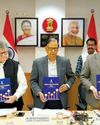
Introduction
According to the IMF blog, Asia’s emerging and developing economies are expected to have a growth rate of 5.3% this year. The major contributor to this growth will be India and China. Most of the multilateral rating agencies are talking about the service sector and hardly speak about industrial production.
No doubt the service sector is one of the major contributors to the growth of the Indian economy. But, industrial production is also one of the contributors to the growth. In this article, we are going to look at what is meant by the Index of Industrial Production (IIP).
What is Industrial Production (IIP)?
The Index of Industrial Production (IIP) conveys the status of production in the industrial sector of an economy in a given period of time, in comparison with a fixed reference point in the past. In simple words, it is an index that details the growth of various sectors in an economy. Indian IIP will focus on sectors like mining, electricity and manufacturing.
History of Industrial Production (IIP):
Many may not be aware that India was the first country to officially attempt to compute the Index of Industrial Production (IIP). With 1937 as the base year covering 15 important industries (at that time), The Office of the Economic Advisor, Ministry of Commerce and Industry made its first attempt at the compilation and release of IIP. At that time, these 15 important industries were accounting for more than 90% of total industrial production.
The first time IIP used the year 1937 as its reference point. It contained only 15 products. Since then, the criteria for the base year as well as the number of products have been revamped nine times (recently in 2011-12).
Denne historien er fra March 1 - 31, 2023-utgaven av BUSINESS ECONOMICS.
Start din 7-dagers gratis prøveperiode på Magzter GOLD for å få tilgang til tusenvis av utvalgte premiumhistorier og 9000+ magasiner og aviser.
Allerede abonnent ? Logg på
Denne historien er fra March 1 - 31, 2023-utgaven av BUSINESS ECONOMICS.
Start din 7-dagers gratis prøveperiode på Magzter GOLD for å få tilgang til tusenvis av utvalgte premiumhistorier og 9000+ magasiner og aviser.
Allerede abonnent? Logg på

NITI Aayog launches the "Fiscal Health Index 2025"
The report also highlights state-specific challenges and areas for improvement.

Convergence of Science and Spirituality ensures a healthier future
Speech of Dr. Prasun Mishra, President AAPM, Chair, WISE Capitals on the 15th World Confluence of Humanity, Power and Spirituality on 27th December 2024

The Crisis in Bolivia
Political leaders must put aside their rivalries and focus on stabilizing the economy.

Assam Government hosts successful Investors' Roadshow in Kolkata
The Assam Government organized a highly successful Investors' Roadshow at Hotel Taj Bengal, Kolkata, serving as a prelude to the much-anticipated \"Advantage Assam 2.0: Investment and Infrastructure Summit 2025.\"

India needs to reform both global and domestic policies to boost core sector growth
The core sector, consisting of key industries such as petroleum and refining, electricity generation, steel production, coal mining, crude oil, natural gas, cement, and fertilizers, requires comprehensive policy reforms to enhance its contribution to the overall industrial output.

Understanding the implications of India's revised GDP growth outlook
India's GDP growth rate forecast for FY25 has recently been revised downwards by several institutions, reflecting a broader economic slowdown.

Achievements and Challenges of a Decade of 'Make in India'
The 'Make in India' initiative, launched in 2014, marks a significant milestone as it completes a decade of efforts to position India as a global manufacturing hub.

Indian Rupee depreciation against the dollar: Why it's not a cause for concern
The daily fluctuations in the exchange rate of the Indian rupee against the dollar have kept the media busy, with many analyses trying to determine the reasons behind its depreciation.

EIILM-Kolkata launches 'MBA Cloud ERP with SAP' in Eastern India
EIILM-Kolkata, a leading Management Institute of Eastern India has taken a historic step towards uplifting the quality of management education in this part of the country.

The IMF World Economic Outlook, January 2025 - An analysis/review
On January 17, 2025, the International Monetary Fund On January 17, 2025, the International Monetary Fund (IMF) released its World Economic Outlook (WEO) update, titled \"Global Growth: Divergent and Uncertain.\"